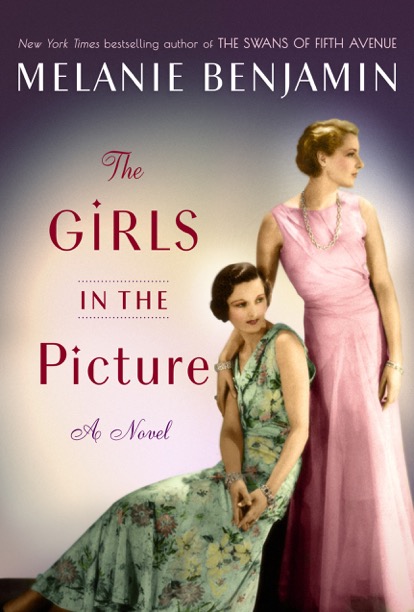
BY JUDY CARMACK BROSS
Before #metoo and #timesup commanded Hollywood, Mary Pickford and Frances Marion did.
Old Town Chicago author Melanie Benjamin has upstaged her recent best-selling novel The Swans of Fifth Avenue in launching her latest, The Girls in the Picture, today on the first leg of her national book tour. The lives of these two silent movie legends, who first met in the spring of 1914 and worked together to become the highest paid movie star and screenwriter in that dawning industry, couldn’t be more timely. Told in the historical fiction format, the book captures Hollywood’s earliest days and the two women who ran it.
“We are seeing their echoes in everything that is happening today, and I imagine that Mary and Frances would be championing the women who are speaking out. They might recognize themselves in the Reese Witherspoon and Nicole Kidman collaboration for Big Little Lies.
“Mary Pickford was the first movie star. Although she was known as ‘the girl with the curls’ or ‘America’s Sweetheart,’ she couldn’t have been more pragmatic. She had her own production company before studios such as MGM even began.
“Frances Marion invented the role of screenwriter, collaborating with Mary on her most successful films. At that time, Hollywood was a level playing field—everyone invented the business together. It was not until the 1990s, over 8 decades later, that Sherry Lansing became the second female production company head.
“When Mary founded Pickford Film Corporation in 1915, she did so because she wanted absolute artistic control. A film’s final cut, the director, casting, even advertising were all determined by her.”
For those who know the name Mary Pickford, images of an angelic adult playing a little girl with ringlets come to mind. She was 25 when Frances wrote The Poor Little Rich Girl, a beyond blockbuster in which she played a child of 11. Mary loved it, partially because she got to skip and play—things that she never got to do as a child. Pushed by her mother, Charlotte, for whom the term ‘stage mother’ might have been pinned, Mary supported her impoverished family from the age of seven.
The impresario David Belasco made her a star of the New York stage as an adolescent, but she endured boarding houses without heat and hot water in depressing road tour destinations. It was Charlotte who insisted she audition for what was called “the flickers,” a name from the nickelodeon days.
Mary, who was born Gladys Smith in 1892 in Toronto, and her best friend, Lillian Gish, who would, too, become a silent star, looked down on the nascent industry at first. After making a few films in New York, they reluctantly agreed to head to Hollywood.
Frances Marion, four years older than Mary, had a privileged childhood in San Francisco. Beginning her career as an artist, her art school had been destroyed by the San Francisco earthquake of 1906. It was Mary who convinced her to become a screenwriter.
Her career would span the silent movies on into the “talkies” for which she wrote Dinner at Eight, Anna Christie, and Camille at MGM. She was the first writer to win two Academy Awards (for The Big House and The Champ) and to command an unheard of annual salary of $50,000 a year. She wrote over 130 screenplays.
“Frances’s life had a good pace from the time she invented the role of screenwriter to when she learned how to write in a whole new way for movies with sound.
“Mary and Frances loved the industry although Mary might have had even more ambition. She hardly thought about anything other than the business of making movies—she had enormous financial determination. Although Mary had close working relationships with movie giants like Charlie Chaplin and D.W. Griffith, she had few close friends. Frances, on the other hand, was a great friend of William Randolph Hearst, wrote for his longtime love Marion Davies, and attended many of the parties at his California castle, San Simeon.”
In addition to writing Rebecca of Sunnybrook Farm and other of Mary’s most successful movies, Frances also directed and appeared in some of Mary’s films. She was also Mary’s confidante as her romance with Douglas Fairbanks blossomed, making them the most famous couple in the world. Toasted as the king and queen of Hollywood, they built the palatial Pickfair, called California’s Buckingham Palace. When the couple divorced, it was Frances to whom Mary came in tears.
“Mary really needed Frances in her personal life as well. Mary was a cautious person who would have no children. Frances built up her confidence. Mary’s first marriage to Owen Moore was physically and emotionally abusive. When Douglas arrived, she was ripe for a true passion.”
Melanie began her book before the recent scandals in Hollywood came to light and spawned awareness-raising campaigns.
“I have been fascinated for a long time with the early Hollywood days and how this level playing field, where everyone was inventing the industry, saw Mary and Frances become the dominant forces. I had proposed the idea to my editor years ago, and finally I received green light.”
Melanie’s national book tour, including speaking engagements in Chicago in February, begins at 2:00 today at Anderson Bookshop in Naperville. A Miami vacation with husband Dennis Hauser awaits the couple following the tour. She then returns to her new novel that she is “in the middle of re-visiting.”
“I felt very fortunate to see in the Douglas Fairbanks Center in Hollywood Frances’s original script for Anna Christie, which starred Greta Garbo. In some ways I identify with Frances, whom I admire for her ability to adapt and even totally change her writing style when the talkies were born.
“Writing is a profession. I think she would agree with me when I say that my words are not my babies. If an editor perceives a problem with them, I will change them.”














